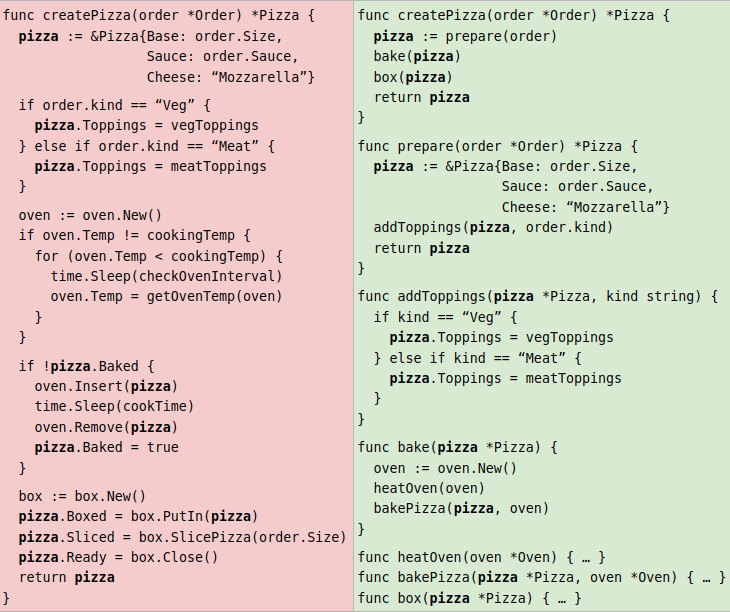Linear code is more readable
published 2023-09-11 [ home ]
You can only claim to be contrarian if people actually defend the opposite viewpoint. Well, one of the “best practices” I disagree with was recently featured in the Google Testing Blog — usually a very good resource, there is a reason that post appeared in my newsreader!
The authors present two versions of a function and ask which one is the most readable.

At first glance, we can already notice the presentation is a bit partisan :) In addition to the obvious background color bias, the authors ellipsed some code on the right-hand side, making both implementations appear roughly the same size when the right one is really much longer.
The authors argue that the function on the right is more readable because it does not mix levels of abstraction, and that makes it more “top-down”. Well, OK, but the function of the left reads linearly from the top of the screen to the bottom, whereas if you want to understand everything that happens on the right-hand side you need to jump back and forth.
You may tell me, sure, but you never need to look at the whole code, that is what abstraction is for! OK. Quick, tell me this: does the function that bakes the pizza also heat the oven, or do you need to preheat it first? Hint: there are two functions. One is called bake and takes a Pizza, and the other is called bakePizza…
Also, what happens if you pass a pizza to those functions twice? Are they idempotent or do you end up eating cinder?
So, you may have guessed that I do not like the code style on the right. But I have to admit something: it is somehow easier to understand than the code on the left. Is that because of the structure that separates the levels of abstraction? Let us see. What about that version?
func createPizza(order *Order) *Pizza {
// Prepare pizza
pizza := &Pizza{Base: order.Size,
Sauce: order.Sauce,
Cheese: “Mozzarella”}
// Add toppings
if order.kind == “Veg” {
pizza.Toppings = vegToppings
} else if order.kind == “Meat” {
pizza.Toppings = meatToppings
}
oven := oven.New()
if oven.Temp != cookingTemp {
// Heat oven
for (oven.Temp < cookingTemp) {
time.Sleep(checkOvenInterval)
oven.Temp = getOvenTemp(oven)
}
}
if !pizza.Baked {
// Bake pizza
oven.Insert(pizza)
time.Sleep(cookTime)
oven.Remove(pizza)
pizza.Baked = true
}
// Box and slice
box := box.New()
pizza.Boxed = box.PutIn(pizza)
pizza.Sliced = box.SlicePizza(order.Size)
pizza.Ready = box.Close()
return pizza
}
Do you recognize it? This is just the left-hand side function code, with function names from the right-hand side added as comments.
I don’t know about you, but this is my favorite. And it looks like the readability just came from explaining what we did properly here, not from extra abstraction layers and indirection.
In conclusion, I stand by what I said earlier: do not extract small functions from linear code, especially if you only use them once. None of the benefits offsets the loss in linearity.
One more thing
I wasn’t sure if I wanted to mention this or not, but I ended up editing the post because there is something that bothers me with this function, and it is that business with the oven.
First, pre-heating the oven is self-contained and should probably be a method of the oven itself. But beyond that, this code makes no sense: why would you create a whole new oven to make a pizza? In real life, you get an oven once, and then you bake a whole lot of pizzas with it, without going through the whole heating cycle.
I know this is a synthetic example but this kind of issue actually occurs in real code and sometimes causes performance issues. It is likely that this code should take the oven as a parameter. Providing it is the job of the caller.
(And since you put the pizza in the box, you probably want an interface where you return the box, not the pizza. Oh well.)